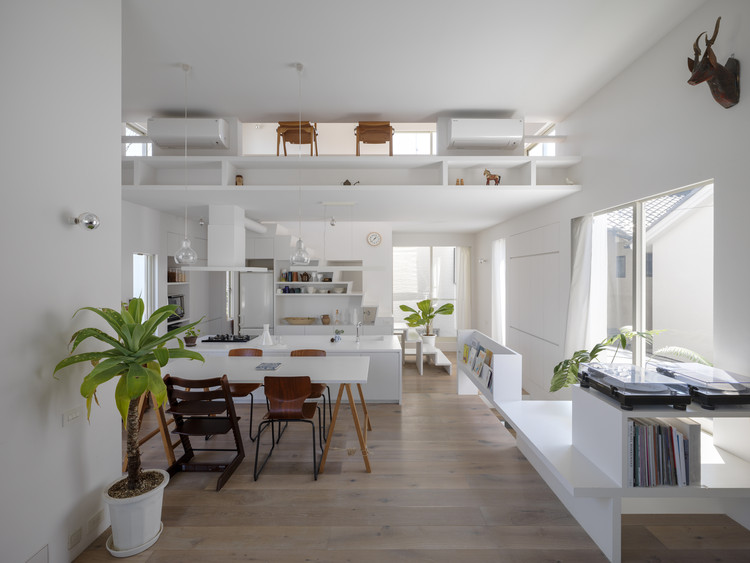
- 项目年份: 2015
-
摄影师:Yasushi Ichikawa

来自建筑师。The site is located in Kitashirakawa, Kyoto adjacent to a stream, the Higashiyama mountains with its ‘Daimonji’ of ‘Gozan-no-Okuribi’ (a summer event in Kyoto) and has distant views to Hieizan mountains. The site overlooks open-spaces both across the street where the local university has a botanical garden, and adjoining where a children's playground is situated. Together the two open spaces turn the site into a corner block.

建筑该如何与场地相呼应?;作为回应,我认为屋顶应该是一个重要的设计理念。在这个安静的住宅区里,狭窄的街道上分布着新旧房屋,它们有着各式各样的外表和屋顶形式。为与周围环境相呼应,我首先选择了一个适当的屋顶来进行研究。然后我决定在项目中采用简单的倾斜式屋顶。而该方案最终经过设计审查小组的讨论后批准了这个从未有过的屋顶形式。它表明了不管房子的规模大小,它都考虑到了城市环境,并且也符合《京都议定书》的规定。
.jpg?1454030880)

.jpg?1454030900)
这是一个4人组成的家庭。开放的主要空间形成了一个单一的空间,并作为是二楼的中心区域,那里是家人的主要活动区域。该空间还连接到三楼,一个空的阁楼,这是一个大型天花板投射平台。你可以住在这个中央空间,来感受所有的家庭生活琐事,象由楼梯在不同楼层上形成的盲点,厨房等等。这是一个简单的框架结构,它可以让许空间伸出去,在设计方案中有对房屋的一致性和连贯性做了详细的说明。

A "band" attached to four sides on the second floor is used as a cabinet and a bay window that creates a space for planting, the display of objects, as well as a bench and a peak. This band reinterprets the traditional ‘En’(veranda-like), ‘Shoin’(study-like) and ‘Toko’(alcove-like) ‘Degoushi’(grilled oriel-like) and transforms an abundant residential configuration into expansiveness space, that acts both physically and psychologically. The “bands” depth thickens the boundary of the wall making the division between in-and-out ambiguous.

The eyes scan rove across planting on a terrace and a peak, cherry blossoms in children's playground, university botanical garden and far mountains, and not just the borrowed scenery from an opened window. In this house the family is living while feeling body movement, a diffuse vision and the experimental links every day act on the unconsciousness.
Satoru Umehara / UME architects




















.jpg?1454030880)
.jpg?1454030890)
.jpg?1454030900)
.jpg?1454030869)

.jpg?1454030943)
.jpg?1454030953)
.jpg?1454030922)
.jpg?1454030933)
.jpg?1454030911)
.jpg?1454030848)
.jpg?1454030859)

